Does your recycling really get recycled? Inside Kansas City area processing plants
Editor’s note: This story is part of The Star’s series “Talking Trash.” All of the stories were inspired by questions and concerns we heard from Kansas Citians through listening sessions, an online callout and other conversations in our community. Stories will run throughout April, and you can find them all here. You can share thoughts in the form at the bottom of this story, or email kcq@kcstar.com. We’d love for you to join Star staff at a community cleanup event this month (more on that further down).
Reduce, reuse, recycle. We’ve all heard it before. Many of us had it drilled into our brains in school growing up, or from family members or friends.
Even though we’ve been told that recycling is the right thing to do, based on what The Star has heard from readers, there are still some pretty big questions lurking in the minds of Kansas Citians.
Mainly: Is recycling even real, and is it worth it?
The Star asked readers about what questions or concerns you have about trash and litter in the metro to help fuel a series of stories we’re starting to publish this week. Residents in at least 12 different ZIP codes around KC asked and shared doubts with us about the effectiveness of recycling.
“I have heard that it doesn’t matter which bin I put my stuff in because it all goes into the dump anyway,” reader and Shawnee resident Harry Reed told The Star.
According to Kansas City Public Works director Michael Shaw, recycling in Kansas City has been decreasing in recent years. Local leaders are trying to reverse that trend by making it easier to recycle.
Starting in May, Kansas City will be delivering brand new recycling carts with lids to each household that currently receives curbside service from the city, but some readers told us it may take more than that to boost recycling in the area.
“Instilling confidence that the contents of the recycling bin actually get recycled would increase participation,” reader and Brookside resident Julia Bean told The Star.
To get to the bottom of your questions, we visited both recycling facilities in the metro — where all of our recycling goes. Here’s what we learned.
Where does Kansas City’s recycling end up?
After your recycling leaves the curb anywhere in the metro, it ends up in one of two recycling facilities, called material recovery facilities. They’re both operated by private companies: One, in Shawnee, is operated by Waste Management, while the other just outside Harrisonville, Missouri, is operated by GFL.
Kansas City’s recycling centers, which are staffed by the local environmental group Bridging the Gap, also send materials to these two facilities.
At these facilities, recycling is sorted by material type and gathered into huge bundles called “bales” for sale to manufacturers.
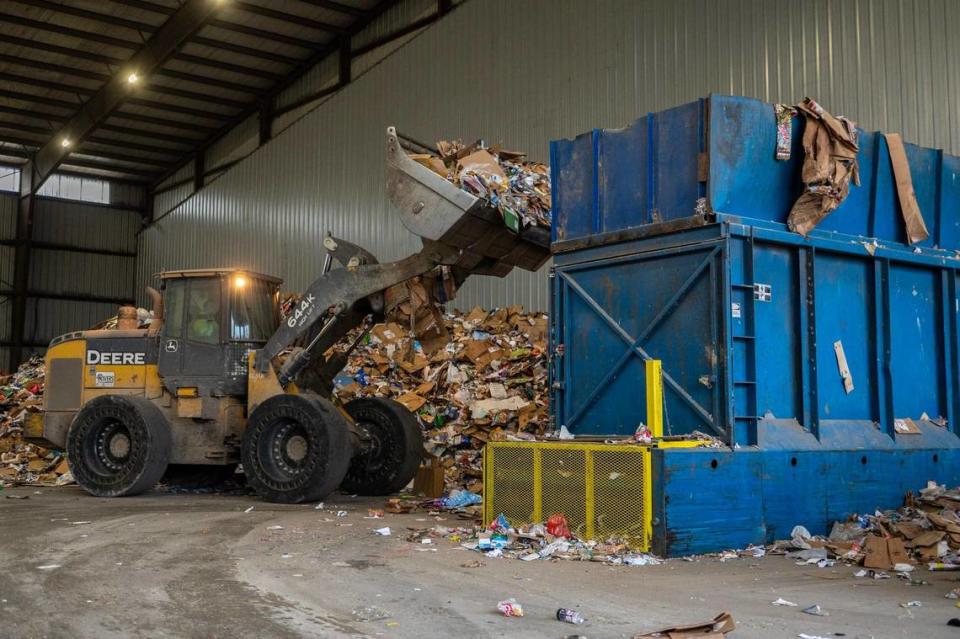
Recycling isn’t standardized across the country. It’s regionalized, and each region’s practices vary based on the market.
In the recycling industry, what is truly “recyclable” depends on what is economically viable to sort and resell to be made into something else. This depends on the existence of an “end market,” a buyer willing to pay for the raw materials that the recovery facilities collect.
“The reality is that almost almost everything in the world is technically recyclable. So it’s not an issue of technical recyclability,” said Tom Szaky, a recycling expert and the CEO of TerraCycle. “Instead, what actually gets something recycled is simply whether the company can make money at recycling that object.”
TerraCycle runs recycling programs in more than 20 countries around the world.
While some materials are more valuable than others, most of what’s recycled in the metro has an end market, according to Matt Riggs, an outreach coordinator with the Mid-America Regional Council’s solid waste division.
For example, many of the plastic water bottles collected in the metro are sold to Mohawk Flooring to make carpets.
But both local facilities’ managers told The Star that upwards of 20% of the material that makes it to the sorting floor isn’t actually recyclable. These are the items that end up in the landfill.
“By and large, recycling is happening as it should,” Riggs said. “If you’re throwing a bunch of stuff in there that isn’t recyclable, yes, the non-recyclable stuff is getting landfilled. But the stuff that is recyclable is getting recycled.”
That gets tricky when it comes to plastics — more on that in a second.
What really goes on inside a materials recovery facility?
The Shawnee Materials Recovery Facility is a massive warehouse in outer Johnson County just south of the Kansas River. Inside, conveyor belts zip in all directions, carrying recycled items past sophisticated sorting cameras, over rotating combs and beneath powerful magnets.
A combination of machines and human sorters divert paper, metal and many varieties of plastic down various chutes, where they are grouped into giant compressed cubes called “bales.”
As The Star toured the cacophonous WM facility, the amount of recycled material was immense. A line of neon-vested workers wearing earplugs plucked stray plastic bottles from a steady stream of paper and cardboard. Another employee expertly drove a small forklift-like machine to stack two huge bales of compressed plastic milk bottles, their colored caps still visible. A men’s rubber flip flop rode by on a slanted conveyor belt.
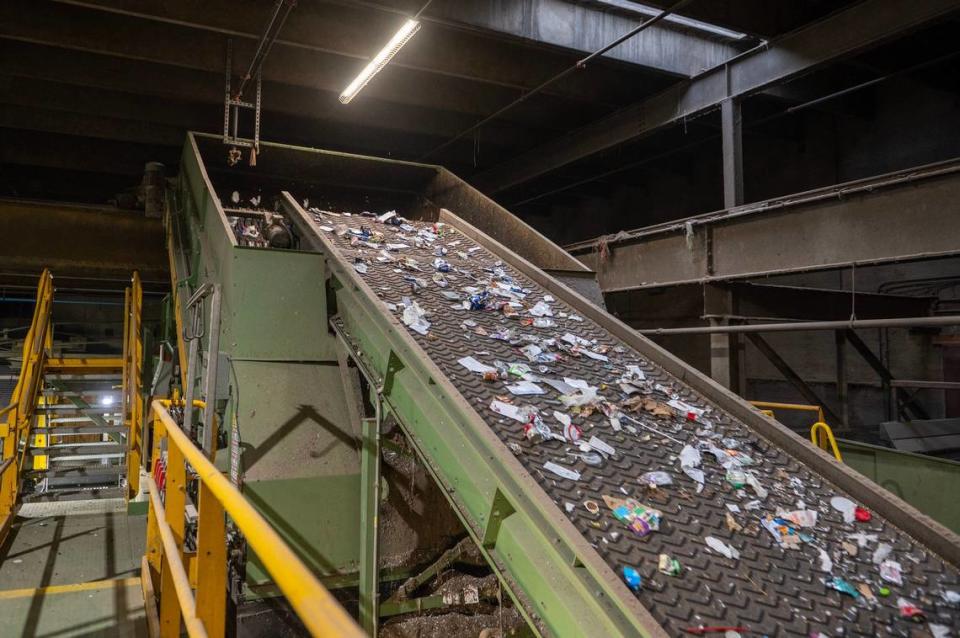
At the front of the facility, a small chute spit non-recyclable materials out onto a small mound. Most of the debris that fluttered down were filmy plastic bags — which Blair said are a major contaminant — and tiny pieces of paper and plastic too small for the recycling equipment to handle.
GFL’s Harrisonville facility is housed in an equally cavernous warehouse, where deafening machinery is intertwined with a network of yellow stairs, ladders and pathways. Human pickers grab filmy plastic and rip trash bags open at the very beginning of the process, reducing contamination farther down the line.
The process is similar to WM’s operation, with one exception — the Harrisonville plant employs two high-speed robots that use cameras to “see” out of place materials as they zip by on a conveyor belt below. The robots then grab items with a small suction device and drop them down nearby chutes to rejoin other items made from the same material.
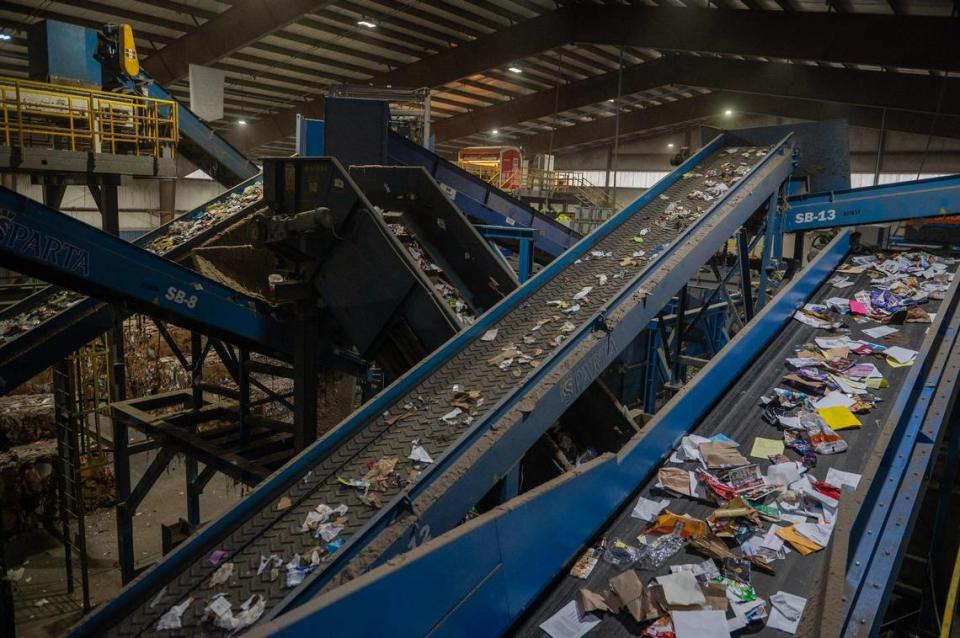
But while the robots’ lightning-quick maneuvers are impressive to the untrained eye, Cooper said they’re no match for a human sorter with highly trained eyes and the ability to grab and hold multiple items in each hand.
“The speed and the ability of that machine is not there to match a human,” he said. “The technology is not there.”
Does some of what I recycle end up in the landfill?
It might. The Star found that a few of the less-common types of plastic are actually ending up in landfills around Kansas City, even though local guidelines tell residents that those plastics are recyclable.
Residents across the metro have been told to recycle plastic containers with resin codes #1 through #7 — those are the little numbers inside the triangle symbol on the bottom of most plastic items.
That’s according to guidance from MARC’s Solid Waste Management District, which serves local governments in Jackson, Cass, Clay, Platte, Ray, Johnson, Leavenworth, Miami and Wyandotte counties. MARC gets its guidance directly from the recycling facilities.
“That’s what they told us: We want one through seven,” Riggs said.
Here’s the problem: Neither facility says it has ever taken plastics with the resin codes #3, #6 or #7 for as long as managers can remember. These plastics include items like PVC pipes, yogurt cups, styrofoam takeout containers and miscellaneous items made from mixed or less common types of plastic.
“There is no market for those,” said Lisa Disbrow, the government and public affairs director at Waste Management, which owns and operates the Shawnee facility. “I don’t think there’s ever been a market.”
“For seven years, I’ve been at this facility and we’ve never accepted them as recyclable,” said Jeremy Cooper, the manager of the GFL recycling plant in Harrisonville. “As far as answering for MARC… I’m not sure why they allow it.”
Riggs from MARC said that his organization is in the process of changing its website and messaging to specify that only plastics #1, #2, #4 and #5 are recyclable in the metro.
But in the meantime, he insisted that MARC’s guidelines are based on information the group got directly from the recycling facilities in 2018.
Why are plastic recycling guidelines different from what actually happens?
Some recycling guidelines have more to do with uniform messaging than with end markets in the area. The wording often comes down to local ordinances and contracts for recycling haulers, says Tom Coffman, GFL’s government contracts manager.
Coffman told The Star that processing facilities all over the region have to accept plastics #1 through #7 — whether they want to or not — because of stipulations in ordinances and contracts.
“Almost every solid waste ordinance in every city that has curbside (recycling) spells out one through seven,” he said. “It’s a combination of contract language and solid waste ordinance language that all haulers and all processors face.”
Kansas City’s solid waste code defines “recyclable materials” as “refuse materials… that are of such a nature that they may be reprocessed or remanufactured for secondary use.”
The city’s website also lists “all plastic bottles and containers marked 1 - 7” as recyclable as long as they have all liquids removed and their caps or lids are attached.
But after these materials have left the curb, cities don’t regulate where they end up. For a few types of plastic, this final resting place is the landfill.
Szaky told The Star that municipal guidelines in the U.S. often allow plastics #1 through #7 as part of the “single stream” model to make recycling easier for consumers — not to mislead them about what will actually be recycled.
“I don’t think it’s malicious,” he said. “This whole idea of single stream recycling was born out of the idea of convenience. What we should encourage is proper communication, so citizens know what’s happening, and then can maybe buy the products that are actually being sorted for recycling.”
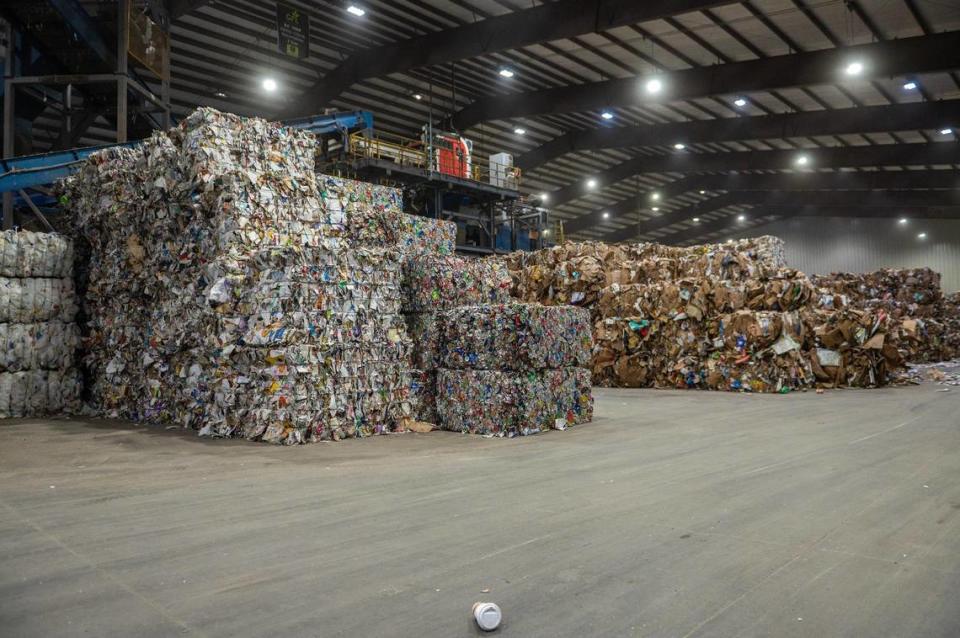
Who buys Kansas City’s recycled materials?
The exact destination of recycled materials from the metro is constantly changing, and facility managers told The Star that it can vary by the truckload.
“For the last year and a half, it’s 100% domestic, and relatively centralized in the Midwest,” said Tronnie Blair, the WM facility’s manager. In the years since China ceased buying many U.S. recyclables, he said the market has adjusted to supply manufacturers closer to home.
Most of the materials that come through the Harrisonville facility end up in the Midwest too — although plant manager Cooper said that some of its cardboard is exported to India, Malaysia and other countries to be repurposed into new cardboard.
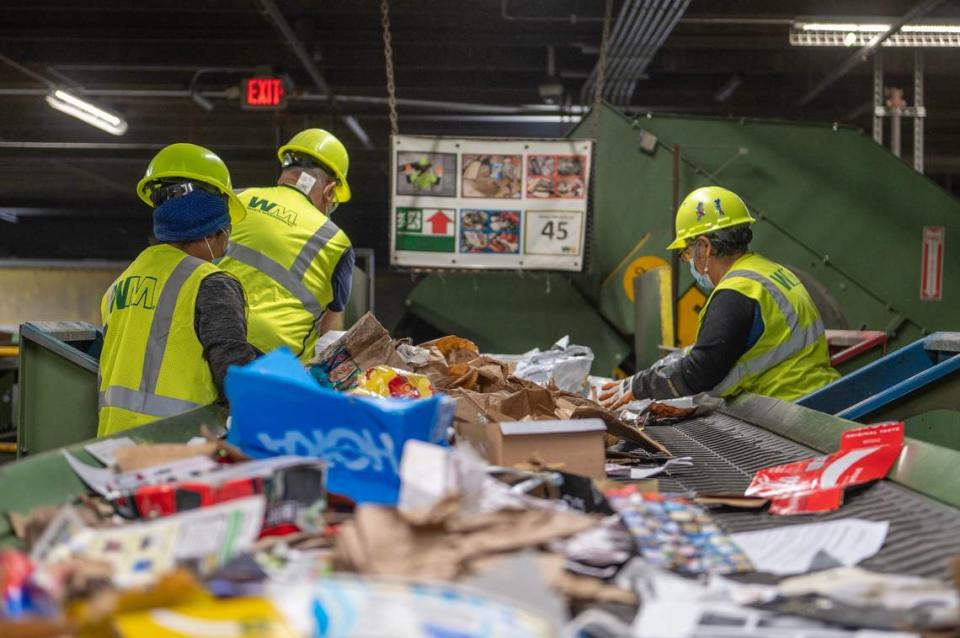
Both plant managers said that around 20% of the items their facilities receive are either contaminated or not recyclable in the first place — that includes plastics #3, #6 and #7. But of the 80% that are recyclable, both say they manage to sell nearly all of it back to manufacturers.
“We have a whole team of people (whom) that’s their job is to sell that stuff,” Blair told The Star. “Do we catch 100%? No, we’re never going to be 100%. But we’re really close.”
How can I make sure my recyclables aren’t sent to the landfill?
Being mindful about what you throw in the recycling bin can help ensure that all your recyclables find a new life.
According to Blair and Riggs, the only time properly recyclable materials are sent to landfills is when they have been contaminated in some way with food, liquids, filmy plastic or hazardous materials.
“Any food, any liquid that gets in a recycling batch is bad news,” Riggs said. “Those can completely contaminate and devalue the fiber streams.”
‘Fiber’ is the recycling industry term for paper and cardboard products, which can be rendered unrecyclable by this residue.
Blair added that a small amount of rainwater or a few smears of yogurt won’t make or break the recycling process — but large amounts of grease, food, paint, plastic coatings and other contaminants can condemn otherwise recyclable materials to the landfill.
Plastic bags and other filmy plastics are the other culprit in making recycling more difficult for facilities.
Blair said the plant has to clean out the rotating combs of one of his facility’s largest sorting machines three or more times a day to remove filmy plastic. At the Harrisonville facility, the problem is even worse — Cooper said his plant stops the machinery up to 12 times per day to clean out the filmy plastic gunk.
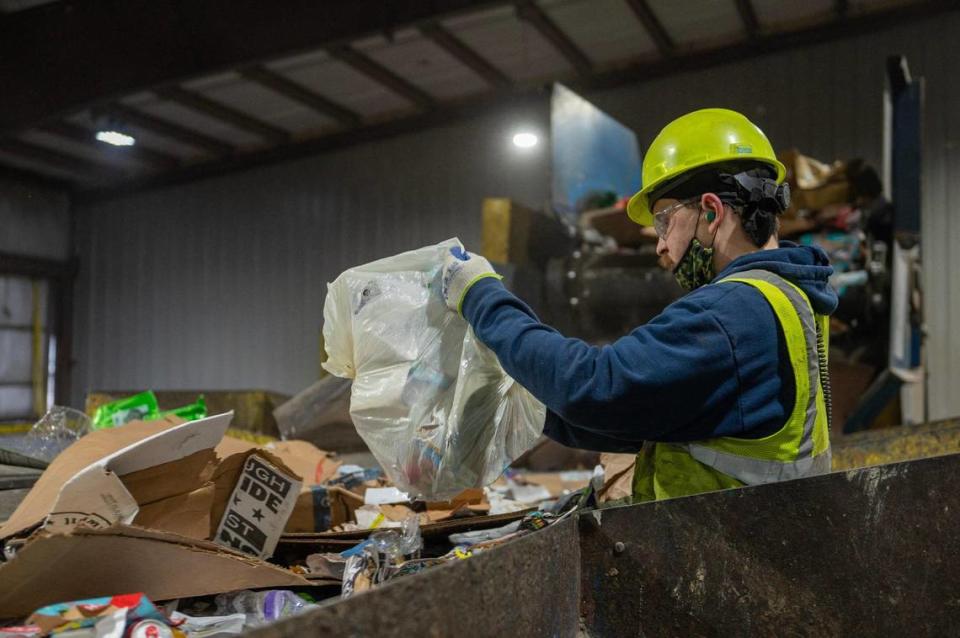
“Single-use plastic bags are the devil in our world,” Coffman said.
Blair said it’s important not to package your recyclables in standard plastic garbage bags. These bags can end up in the landfill when workers don’t have time to tear them open and empty out the recyclables inside.
“If our operators have time to open those bags and dump them, they will, but the vast majority of them, they just simply don’t have time,” he said. “I mean, we’re running 25 tons an hour through the system. So we don’t have time to stop and open every bag.”
Instead, he asked recyclers to leave their items loose in their bins or recycling carts.
So — is recycling really worth it?
While not everything you recycle will make it to a new life with a manufacturer, Riggs advised anyone still skeptical about the efficacy of recycling to trust the laws of economics.
“If there wasn’t money to be made, it wouldn’t be happening,” he said. “They have really good end markets for everything that they’re accepting.”
Szaky told The Star that despite some materials being diverted to landfills, recycling still benefits the planet.
“Recycling is significantly better than disposal and the requirement of creating new materials,” he said. “People love disposability… it has great affordability and great convenience. And so in a disposable world, we need to have an effective recycling system.”
Shaw added that he hopes new city policies, like lidded carts, will help spur increased recycling and reduce the amount of waste that ends up in Kansas City’s rapidly filling landfills.
“People recycle to what their abilities are. They recycle to their capacity,” he told The Star. “Being intentional about recycling and reducing the amount of waste you put out there requires a lot of these conversations.”

